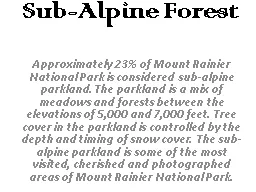

Approximately 23 of Mount Rainier National Park is considered subalpine parkland The parkland is a mix of meadows and forests between the elevations of 5000 and 7000 feet Tree cover in the parkland is controlled by the depth and timing of snow cover The subalpine parkland is some of the mos ID: 207075
Download Presentation The PPT/PDF document "Sub-Alpine Forest" is the property of its rightful owner. Permission is granted to download and print the materials on this web site for personal, non-commercial use only, and to display it on your personal computer provided you do not modify the materials and that you retain all copyright notices contained in the materials. By downloading content from our website, you accept the terms of this agreement.
Slide1
Sub-Alpine Forest
Approximately 23% of Mount Rainier National Park is considered sub-alpine parkland. The parkland is a mix of meadows and forests between the elevations of 5,000 and 7,000 feet. Tree cover in the parkland is controlled by the depth and timing of snow cover. The sub-alpine parkland is some of the most visited, cherished and photographed areas of Mount Rainier National Park.Slide2
Warmer summer temperatures increase the population of bark beetles such as the White Pine Beetle, the Douglas
Fir Beetle
and the Fir Engraver Beetle by speeding up the beetle life cycle so that there are more beetles breeding at one time.Slide3
Trees are stressed by warmer temperatures, drier soil conditions, and earlier spring peak runoff (due to a shorter snow season
) and produce less of the resin that repels bark beetles. When a bark beetle finds a stressed tree, it uses
its pheromones
to ‘call’ its friends, who then attack and kill the tree by boring underneath the tree’s bark and limiting
the tree’s
ability to transport nutrients from its roots to its needles. Bark beetles further impact living trees by infecting
them with
a fungal infection called “Blue Stain” that can also weaken a tree’s defenses. Trees infected with bark beetles
and fungal
infections eventually die
.Slide4
The combination of warmer temperatures, less water, dead trees due to bark beetle infestation and longer frost-free seasons
result in a longer and more robust wildfire season.
Fire
impacted areas are more prone to
erosion, leading
to an increase of sediment in the rivers, thus affecting fish species.
Fire destroys
the habitats of many
small mammals
and birds. In contrast, ash provides nutrients to soil, making burned areas very fertile for plant species.
Non-native
species are often more adapted to cope with the warmer temperatures and drought conditions
may that
caused
the fire danger in the first place and
displace
the native species.Slide5
Mountain wildflower meadows exist in a delicate climatic balance because heavy winter snow cover and a short
summer growing
season limit the survival of woody plant seedlings. When the frost-free season lengthens, tree seedlings are
better able
to survive and slowly crowd out and shade the meadow grasses and wildflowers.
Subalpine
fir is already invading
the Paradise
meadows by taking advantage of mild years to establish. Then the Firs are able to form ‘islands’ of trees
that buffer
individual trees against cold and snow.Slide6
Small mammals, such as pika and marmots, are dependent upon alpine meadow grasses and low-lying berries for food.
As meadow
grasses disappear, the populations of these already endangered animals will likely further decrease.
Many
of these plants remain an important part of Native American culture and have been collected in the park for at
least 3,400 years.Slide7
A longer frost-free period causes alpine habitats to move higher in elevation and encroachment of subalpine trees into formerly
alpine communities. Some of the heather communities have persisted on Mount Rainier for 10,000 years.
Visitors to Mount Rainier often come to view the blooming wild flowers and the snow-covered alpine spaces and hike
in the
spindly subalpine forests. Dislocation, destruction or retreat of these features further up in elevation, may
negatively impact
the visitor
experience.Slide8Slide9